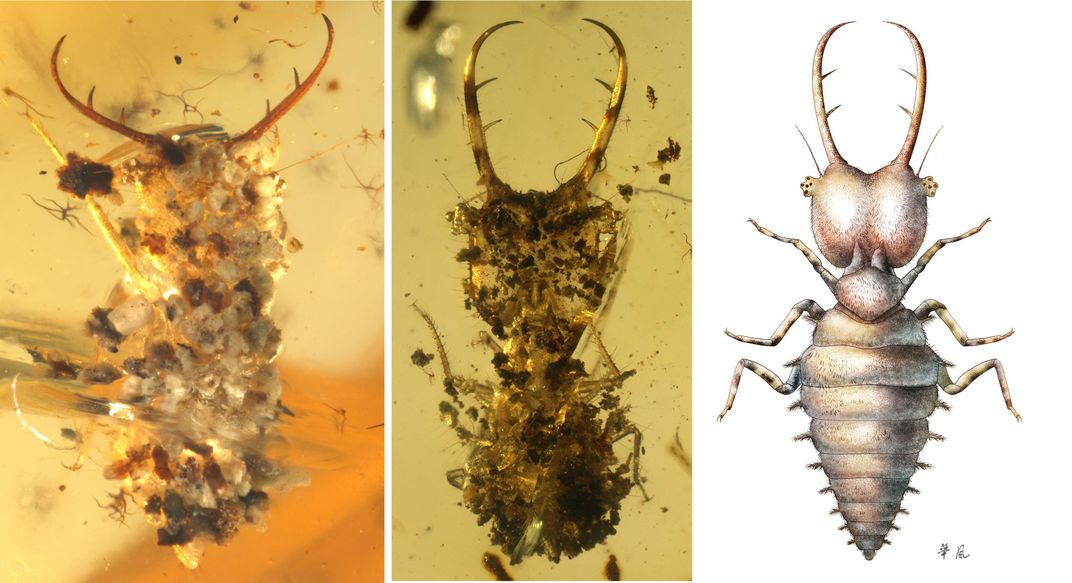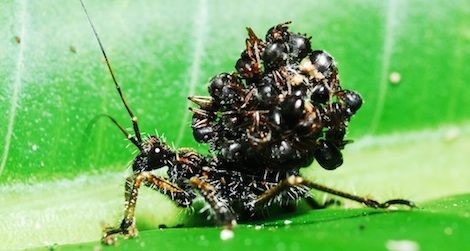Some Ancient Insects Wore the Exoskeletons of Other Bugs to Disguise Themselves
New amber specimens show that insects have been mastering the art of disguise for 100 million years
/https://tf-cmsv2-smithsonianmag-media.s3.amazonaws.com/filer/85/b5/85b50f13-158a-48cf-a968-558db8635ca6/wang1hr.jpg)
The American military has been perfecting the art of disguise for more than a hundred years, employing a variety of materials and mimicking natural patterns to make soldiers invisible to enemy eyes. But don’t be too impressed: insects, it turns out, have been doing the same thing for a hundred million years. Ancient bugs cleverly covered themselves with dirt, wood, leaves and even the remains of their victims to become invisible to prey and predators alike.
Alas, their elaborate disguises couldn't save them from a sticky fate. Sometime in the Mid-Cretaceous, many of these insects met their end encased in fossilized tree resin, their bodies trapped in time for millions of years. Now their downfall has become researchers’ good fortune: scientists have uncovered dozens of these obscured insects in pieces of amber, revealing that using your surroundings to disguise yourself is an ancient practice among insects—and one that evolved separately in different species before spreading across the world.
A team led by Bo Wang, of the Chinese Academy of Sciences in Nanjing, pored through more than 300,000 amber fossils from around the world to find 39 examples described in the June 24 issue of Science Advances. Wang and his colleagues report on more than three dozen insects that were adept at the art of 'debris-camo', including Chrysopidae (green lacewings), Myrmeleontoid (split-footed lacewings and owlflies), and Reduviidae (assassin bugs).
To Wang, the discovery that so many ancient insects deployed this kind of camouflage came as a surprise, given that Cretaceous ecosystems and plants were markedly different than our own. “Debris-carrying camouflage behaviors of extant insects are commonly closely related to angiospermous (flowering) plants,” he notes. “Our findings suggest that complicated debris-carrying camouflage behaviors were already widespread in three groups of insects prior to the rise of flowering plants.”
The find is a "fantastic discovery," according to entomologist Catherine Ann Tauber of Cornell University and the University of California, Davis, who was not involved in the research. Prior to the study, the behavior had been spotted in only a single ancient example, a green lacewing larva preserved in Spanish amber from the Mesozoic era. Yet, given what we know about how living larvae use camouflage, the fact that many ancient insects also used this kind of behavior did not surprise Tauber. “Organisms tend not to leave themselves unprotected,” notes Tauber, who wasn't involved in the study.
Covering yourself with stuff you find on the ground is a more complex behavior than it might at first appear. (The same goes for the behavior of other debris-camouflagers like crabs, spiders and snails.) First, it requires the camouflagers to actively recognize which natural materials will enable them to effectively hide themselves. Then, they need to collect those materials and utilize them to create a disguise that perfectly matches their environment.
Usually, insects learn these skills at a very young age: the technique tends to be prevalent among immature insects because the weighty disguises of soil or sticks would impede flying in mature adults. All of the 39 amber fossil specimens were juveniles.

Some insects even wear the armor of their enemies. Modern-day lacewings—and, presumably, their ancient counterparts—inject victims with saliva that liquefies their tissues, so that they can be sucked through the predator's jaws. After this insect smoothie is consumed, all that's left behind is an exoskeleton. This tough, empty husk can then be worn on the killer’s back as a particularly gruesome disguise, harkening back to the wolf that ate Red Riding Hood’s grandmother and then dressed up in her clothes.
As you might expect, these camouflage behaviors take considerable effort. But the challenge can be worth it, for both predator and prey animal. While an insect may blend into their surroundings to avoid being eaten, that same insect may do the same to lie in ambush and snatch an unsuspecting meal.
In fact, the trick has proved powerful enough to crop up several times in evolutionary history. “It evolved separately in three groups of Cretaceous insects, some of which were later distributed [widely] in the world,” says Wang. “One example is that fossil reduviids (relatives of today's assassin bugs) possessed anchor setae (bristles) on the dorsum which are used to adhere dust and debris, like extant reduviids.”
Some examples Wang’s team uncovered were unlike anything they had seen—because those insects and their unique adaptations no longer exist. For example, one group of green lacewings features bristly nodules on the thorax and abdomen that form a “dorsal basket” to hold debris. “The morphological structures that the ancient lacewing larvae used to hold the debris on their bodies are completely different from the structures that occur on modern larvae,” says Tauber.
What these differences mean is an intriguing evolutionary question, she adds. The question is: Did debris-camouflage in modern insects evolve from these quite different features in ancient specimens? Or did the behavior arise again independently, through different genetic paths? Once they figure that out, perhaps researchers can address another mystery: which came first, the debris-carrying species of such insects or their naked relatives, who survive today without donning any camouflage at all.
